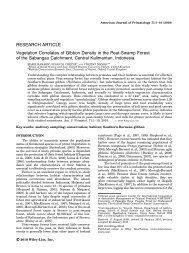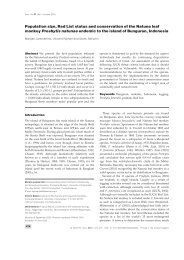Seasonal variation in naturally occurring mobbing ... - Vincent Nijman
Seasonal variation in naturally occurring mobbing ... - Vincent Nijman
Seasonal variation in naturally occurring mobbing ... - Vincent Nijman
Create successful ePaper yourself
Turn your PDF publications into a flip-book with our unique Google optimized e-Paper software.
Mobb<strong>in</strong>g <strong>in</strong> drongos<br />
27<br />
whereas its relatively large gape allows it to carry eggs away from the nest <strong>in</strong> the<br />
beak. Hence, <strong>in</strong> all likelihood, the Javan hawk-eagle is not a significant predator of<br />
drongos, and poses little threat to their eggs and nestl<strong>in</strong>gs. The black eagle, however,<br />
is expected both to hunt the drongos themselves and to pose an especially large<br />
threat to the eggs and nestl<strong>in</strong>gs.<br />
If the hypothesis that mobb<strong>in</strong>g serves as a nest (or offspr<strong>in</strong>g) defence mechanism<br />
is correct, it is expected that (a) mobb<strong>in</strong>g should be more <strong>in</strong>tense towards the<br />
egg and nest predat<strong>in</strong>g black eagle compared to the relatively harmless Javan<br />
hawk-eagle and (b) mobb<strong>in</strong>g should be more <strong>in</strong>tense dur<strong>in</strong>g the drongo’s breed<strong>in</strong>g<br />
season.<br />
METHODS<br />
Data acquisition<br />
I studied mobb<strong>in</strong>g behaviour of drongos towards eagles at three study areas <strong>in</strong> western<br />
Java, i.e. Mt Gede-Pangrango (107°00’E, 06°45’S: 1994-2001), Mt Slamet (109°15’E, 07°15’S:<br />
1994-1995), and Mts Dieng (109°35’E, 07°06’S: 1994-2001) (for a description of the study<br />
areas, see VAN BALEN et al. 2001). Observations were made from ridges, vantage po<strong>in</strong>ts and<br />
watchtowers with a total effort of > 300 days <strong>in</strong>side forested areas. The eagles occur at low<br />
population densities and <strong>in</strong> all, I had 110 contact hr with Javan hawk-eagles (73 hr dur<strong>in</strong>g the<br />
breed<strong>in</strong>g season of drongos; see below) and 84 with black eagles (37 hr dur<strong>in</strong>g the breed<strong>in</strong>g<br />
season).<br />
Mobb<strong>in</strong>g behaviour is only one phase <strong>in</strong> a cont<strong>in</strong>uum of behavioural response to a<br />
predator that ranges from flee<strong>in</strong>g to attack<strong>in</strong>g (SIMMONS 1952). Visual displays and vocalisation<br />
<strong>in</strong> comb<strong>in</strong>ation with closely approach<strong>in</strong>g a predator are widely considered to constitute<br />
mobb<strong>in</strong>g (e.g. SHEDD 1982), but the context <strong>in</strong> which e.g. physical attacks are performed differ<br />
from those when mobb<strong>in</strong>g is restricted to just vocalis<strong>in</strong>g. In the analysis, I therefore only<br />
<strong>in</strong>cluded direct attacks <strong>in</strong> which physical contact with the eagle was made. Attacks consist of<br />
short dash<strong>in</strong>g flights, and/or repetitive strikes, performed by one or several birds (NIJMAN &<br />
SÖZER 1995). The <strong>in</strong>tensity of the attack was measured directly by the duration of the attack<br />
and <strong>in</strong>directly by the response of the eagle. For analysis the duration of the attack was<br />
ordered along an ord<strong>in</strong>al scale from short (1-5 sec), to medium (5-20 sec) to long (> 20 sec).<br />
Likewise, the response of the eagle to the attack was subjectively classified on an ord<strong>in</strong>al<br />
scale: <strong>in</strong>different (the eagle appears to ignore the attack with almost no change <strong>in</strong> flight pattern<br />
noted, although the bird may be vocalis<strong>in</strong>g), actively avoid<strong>in</strong>g (the eagle ma<strong>in</strong>ta<strong>in</strong>s its<br />
flight <strong>in</strong> a straight l<strong>in</strong>e but responds to each attack by a drop <strong>in</strong> height), or defend<strong>in</strong>g (the<br />
eagle actively defends itself by los<strong>in</strong>g height and turn<strong>in</strong>g on its back to deter the attack).<br />
Although the drongos were not <strong>in</strong>dividually recognisable, the study was conducted at a great<br />
number of localities throughout the study areas over a period of 8 years, so most observations<br />
can be assumed to be of different drongos, and therefore are <strong>in</strong>dependent.<br />
Analysis<br />
In the study areas four species of drongo are present. Analysis was restricted to the two<br />
most common species, i.e. black drongo Dicrurus macrocercus and ashy drongo D. leucophaeus.<br />
These two species are very similar morphologically and ecologically. On Java, they<br />
occur over a similar altitud<strong>in</strong>al range with, however, ashy drongo hav<strong>in</strong>g a greater preference<br />
for forest and black drongo for more open habitats (S. VAN BALEN pers. comm.). Breed<strong>in</strong>g <strong>in</strong><br />
western Java occurs largely from April to June (Fig. 1), co<strong>in</strong>cid<strong>in</strong>g with the beg<strong>in</strong>n<strong>in</strong>g of the










